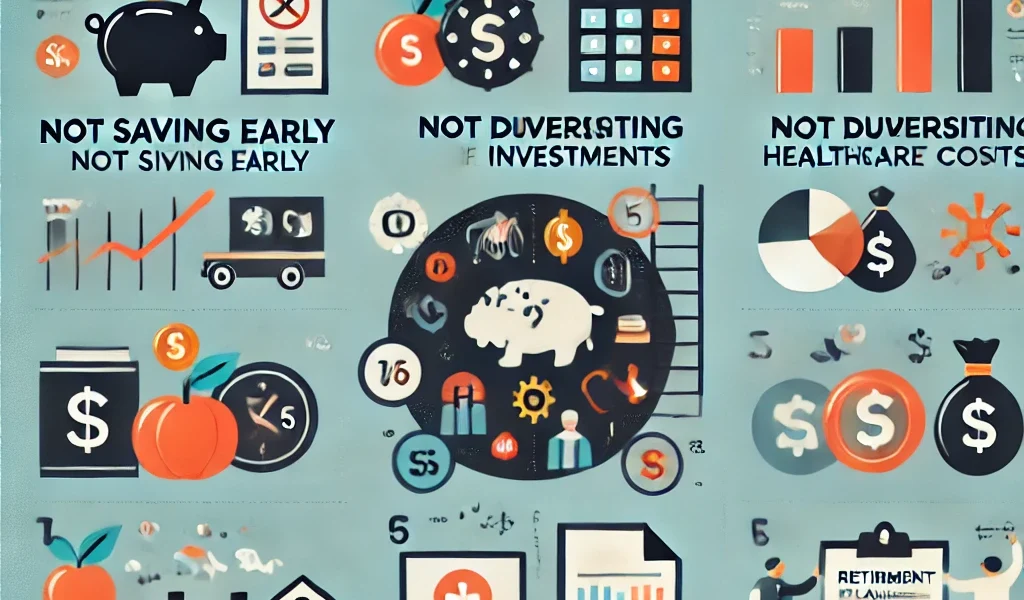Retirement Planning Mistakes to Avoid and How to Fix Them – Which One Offers the Best Returns?
Introduction
Planning for retirement can be overwhelming. With so many options available, it’s easy to make mistakes that could harm your financial future. Whether you’re just starting to save or you’re nearing retirement, making the wrong decisions can have a significant impact on your financial security.
In this blog, we’ll explore the most common retirement planning mistakes people make and offer solutions to fix them. We’ll also discuss how to choose the best retirement plans that offer the highest returns and help ensure a secure retirement.
1. Not Starting Early Enough
Mistake:
One of the biggest mistakes in retirement planning is not starting early enough. The earlier you begin saving and investing, the more time your money has to grow through compound interest.
Solution:
Start saving for retirement as soon as possible, even if it’s just a small amount.
✔ Start in your 20s if possible to benefit from decades of compound growth.
✔ Use tax-advantaged accounts like 401(k)s and IRAs to grow your savings faster.
✔ Automate your savings so that you regularly contribute without thinking about it.
💡 Tip: Even contributing small amounts early can add up to a large retirement fund.
2. Not Taking Advantage of Employer Matching
Mistake:
Many people don’t take full advantage of their employer’s 401(k) match. Employer matching is essentially free money, but if you don’t contribute enough to get the full match, you’re leaving money on the table.
Solution:
✔ Contribute at least enough to get the full employer match.
✔ If your employer offers a 50% match on the first 6% of your salary, make sure to contribute 6% to get the full match.
💡 Tip: If your employer offers a match, it’s like getting an instant 50-100% return on your investment.
3. Failing to Diversify Investments
Mistake:
Investing too heavily in one asset class, such as stocks or bonds, can leave you vulnerable to market downturns. Many retirement portfolios lack proper diversification.
Solution:
✔ Diversify your retirement portfolio by investing in a mix of stocks, bonds, mutual funds, and real estate.
✔ Consider investing in index funds or target-date funds for automatic diversification.
✔ Adjust your asset allocation based on your age and risk tolerance.
💡 Tip: The right balance between growth (stocks) and stability (bonds) will help reduce risk while allowing for long-term growth.
4. Underestimating Healthcare Costs in Retirement
Mistake:
Many people underestimate how much they will spend on healthcare in retirement. Medical expenses often rise with age, and Medicare doesn’t cover everything.
Solution:
✔ Plan for healthcare expenses by saving in a Health Savings Account (HSA) if eligible.
✔ Understand what Medicare covers and consider additional supplemental insurance.
✔ Factor in potential long-term care costs and create a plan for covering them.
💡 Tip: Health savings accounts (HSAs) provide triple tax benefits and can be used to pay for qualified medical expenses.
5. Relying Too Much on Social Security
Mistake:
Social Security is meant to be a supplement to your retirement income, but many people mistakenly rely on it as their primary source of income.
Solution:
✔ Maximize your savings through employer plans (401(k)), IRAs, and other retirement accounts.
✔ Delay Social Security benefits until age 70 to maximize the monthly benefit.
✔ Don’t rely solely on Social Security; ensure you have other retirement income sources.
💡 Tip: Social Security should be seen as a supplement to your retirement income, not a replacement.
6. Ignoring Inflation
Mistake:
Inflation can erode the purchasing power of your retirement savings. Many people don’t account for the rising cost of living and the impact it has on their ability to afford retirement expenses.
Solution:
✔ Invest in inflation-protected assets such as TIPS (Treasury Inflation-Protected Securities) and real estate.
✔ Focus on growth investments like stocks or index funds that typically outpace inflation over time.
✔ Consider including dividend-paying stocks in your portfolio for consistent, inflation-adjusted income.
💡 Tip: Keep your retirement funds invested in assets that outpace inflation to ensure that your purchasing power remains intact.
7. Not Having a Clear Retirement Goal
Mistake:
A lack of a clear retirement goal can lead to a lack of direction in your retirement planning. Without specific goals, it’s easy to become complacent or unfocused.
Solution:
✔ Set clear retirement goals: How much money do you need to live comfortably? What kind of lifestyle do you want?
✔ Estimate your retirement expenses and compare them to your expected retirement income.
✔ Create a retirement budget to track your progress and ensure you stay on track.
💡 Tip: Setting a retirement goal gives you something to work towards and keeps you motivated.
8. Not Planning for Taxes in Retirement
Mistake:
Failing to plan for the taxes you’ll pay in retirement is another common mistake. Withdrawals from Traditional IRAs, 401(k)s, and other pre-tax accounts are subject to income tax.
Solution:
✔ Create a tax-efficient withdrawal strategy. Consider withdrawing from Roth accounts first to minimize taxes.
✔ Convert Traditional IRAs to Roth IRAs before retirement to reduce future taxable income.
✔ Spread out withdrawals from retirement accounts to avoid higher tax brackets.
💡 Tip: Tax planning is essential to ensure that you don’t pay more in taxes than necessary during retirement.
9. Overestimating Your Retirement Spending Needs
Mistake:
Many people overestimate how much they will need to spend in retirement. While it’s important to save as much as possible, overestimating expenses can lead to unnecessary savings and reduced quality of life during retirement.
Solution:
✔ Accurately estimate your retirement expenses based on your current lifestyle and expected changes in retirement.
✔ Consider factors like healthcare costs, travel plans, and housing.
✔ Leave room in your budget for unexpected expenses.
💡 Tip: Track your expenses and consider speaking with a financial advisor to help determine your retirement spending needs.
10. Not Having a Succession Plan
Mistake:
Many people fail to plan for the transfer of their wealth to heirs in an efficient way. Without a proper plan, your estate could be subject to high taxes and legal complexities.
Solution:
✔ Create a will to specify how your assets will be distributed.
✔ Set up trusts to reduce estate taxes and provide for heirs in a controlled way.
✔ Review your beneficiaries on retirement accounts to ensure they are up to date.
💡 Tip: A succession plan ensures your wealth is transferred efficiently and in accordance with your wishes.
Best Retirement Plans for Maximizing Returns
| Retirement Plan | Max Contribution (2024) | Key Benefits | Best For |
|---|---|---|---|
| 401(k) | $23,000 ($30,500 if 50+) | Employer match, tax deferral | Employees with access to 401(k) |
| Roth IRA | $7,000 ($8,000 if 50+) | Tax-free growth and withdrawals | Young investors, high-growth savers |
| Traditional IRA | $7,000 ($8,000 if 50+) | Tax deductions, tax-deferred growth | Lower-income earners |
| Health Savings Account (HSA) | $3,850 (individual), $7,750 (family) | Tax-free withdrawals for healthcare | Healthcare-focused retirees |
💡 Tip: The Roth IRA offers the best long-term returns due to its tax-free growth. However, 401(k)s with employer matching are great for maximizing tax-deferred growth.
Final Thoughts: Ensuring a Successful Retirement
✔ Avoiding common mistakes is key to securing your retirement.
✔ Start early, diversify investments, plan for taxes, and set clear goals.
✔ Maximize returns by choosing tax-efficient retirement accounts like Roth IRAs, HSAs, and 401(k)s.
By planning carefully and avoiding common errors, you can ensure that your retirement is financially secure and free of unnecessary stress.
Disclaimer:
This blog is for informational purposes only and does not constitute financial or legal advice. Please consult a financial advisor to tailor a retirement plan to your specific needs.




